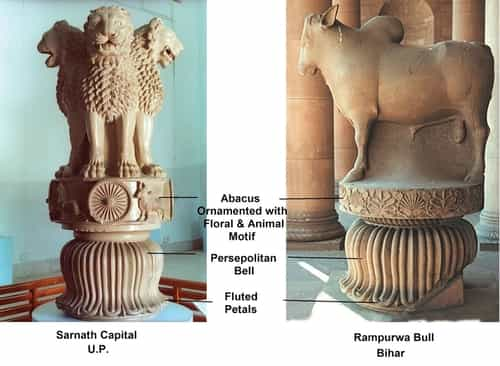Arts of the Mauryan Period for MP State Subordinate exams
- Religions of the shraman tradition, i.e., Jainism and Buddhism emerged around the 6th century BC in the Gangetic valley. Both religions became popular especially Buddhism as they opposed the varna and jati (caste) systems of the Hindu religion.
- The Mauryas had established themselves as a great power in the 4th century BC and they had large parts of India under their control by the 3rd century BC. Ashoka, the powerful king of this dynasty, patronized the shraman tradition in the third century BC.
- At this time there were many modes of religious practices including the worship of Yakshas and mother-goddesses. Yaksha worship was very popular before and after the advent of Buddhism and it was assimilated into Buddhism and Jainism.

Pillars & Sculptures
- Construction of monastic establishments i.e., stupas and viharas became part of the Buddhist tradition. However, in this period, stone pillars, rock-cut caves, and monumental figure sculptures were also carved at several places.
- Erection of pillars was common in the Achaemenian Empire also. But the Mauryan pillars are different from the Achaemenian pillars. The Achaemenian pillars were constructed in pieces, the Mauryan pillars were rock-cut.
- Stone pillars with inscriptions engraved on them can be seen all over the Mauryan Empire. The top portion of the pillar was carved with capital figures like the bull, the lion, the elephant, etc. These capital figures are carved standing on a square or circular abacus. The abacuses are on the base which could be a stylized inverted lotus.
- Examples of pillars with capital figures: Sarnath, Basarah-Bakhira, Rampurva, Sankisa and Lauriya-Nandangarh.
- Large statues mostly in a standing position with polished surface of Yakshas and Yakshinis (Demi-gods and demi-goddesses) have been found in various parts of India like Didarganj (Patna), Vidisha and Mathura, showing the popularity of Yaksha worship.

Terracotta figurines
- Rock-cut elephant at Dhauli (Orissa): Depicts modelling in round with linear rhythm. It also has Ashokan rock-edict.
- Rock-cut cave carved at Barabar hills near Gaya (Bihar): Also known as the Lomus Rishi cave. The facade of the cave is decorated with the semicircular chaitya arch (Semi-circular arch with pointed tip in the centre towards the top) as the entrance. The elephant frieze carved in high relief on the chaitya arch shows considerable movement. The interior hall of this cave is rectangular with a circular chamber at the back. The entrance is located on the side wall of the hall. The cave was patronised by Ashoka for the Ajivika sect.
Stupas
- Stupas were constructed over the relics of the Buddha at Rajagraha, Vaishali, Kapilavastu, Allakappa, Ramagrama, Vethadipa, Pava, Kushinagar and Pippalvina, which shows the popularity of Buddhism. The textual tradition also mentions construction of such kind of stupas at Avanti and Gandhara which are outside the Gangetic valley.
- In the second century BC, stupas were elaborately built with certain additions like the enclosing of the circumambulatory path with railings and sculptural decoration.
- The stupa consists of a cylindrical drum and a circular anda with a harmika and chhatra (Umbrella like structure on top of the stupa) on the top. Apart from the circumambulatory path, gateways were added.
- Stupa, vihara and chaitya (place of congregation and worship) are part of Buddhist and Jaina monastic complexes but the largest number belongs to the Buddhist religion. Examples:
- Stupa at Bairat (Rajasthan) in the third century BC is. It is a very grand stupa having a circular mound with a circumambulatory path.
- Great stupa at Sanchi (Madhya Pradesh) was built with bricks during the time of Ashoka and later it was covered with stone and many new additions were made.

Inscriptional Evidences
- From the second century BC onwards, inscriptional evidences are found mentioning donors and, their profession. Patrons range from lay devotees to gahapatis and kings.
- Donations by the guilds are also mentioned at several sites. However, there are very few inscriptions mentioning the names of artisans like Kanha at Pitalkhora and his disciple Balaka at Kondane caves.
- Artisans’ categories like stone carvers, goldsmiths, stone-polishers, carpenters, etc. are also mentioned in the inscriptions. Traders recorded their donations along with their place of origin.
- During the early phase of Buddhism, Buddha is depicted symbolically through footprints, stupas, lotus throne, chakra, etc.
- Events from the life of the Buddha (related to the birth, renunciation, enlightenment, dhammachakrapravartana, and mahaparinibbana (death)), the Jataka stories (Chhadanta Jataka, Vidurpundita Jataka, Ruru Jataka, Sibi Jataka, Vessantara Jataka and Shama Jataka), were depicted on the railings and torans of the stupas. Mainly synoptic narrative, continuous narrative and episodic narrative are used in the pictorial tradition.
MPPSC के लिए Complete Free Study Notes, अभी Download करें
Download Free PDFs of Daily, Weekly & Monthly करेंट अफेयर्स in Hindi & English
NCERT Books तथा उनकी Summary की PDFs अब Free में Download करें





Comments
write a comment